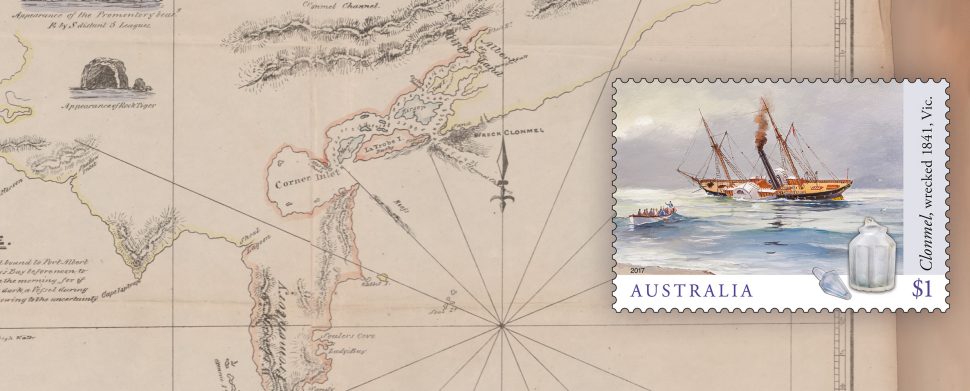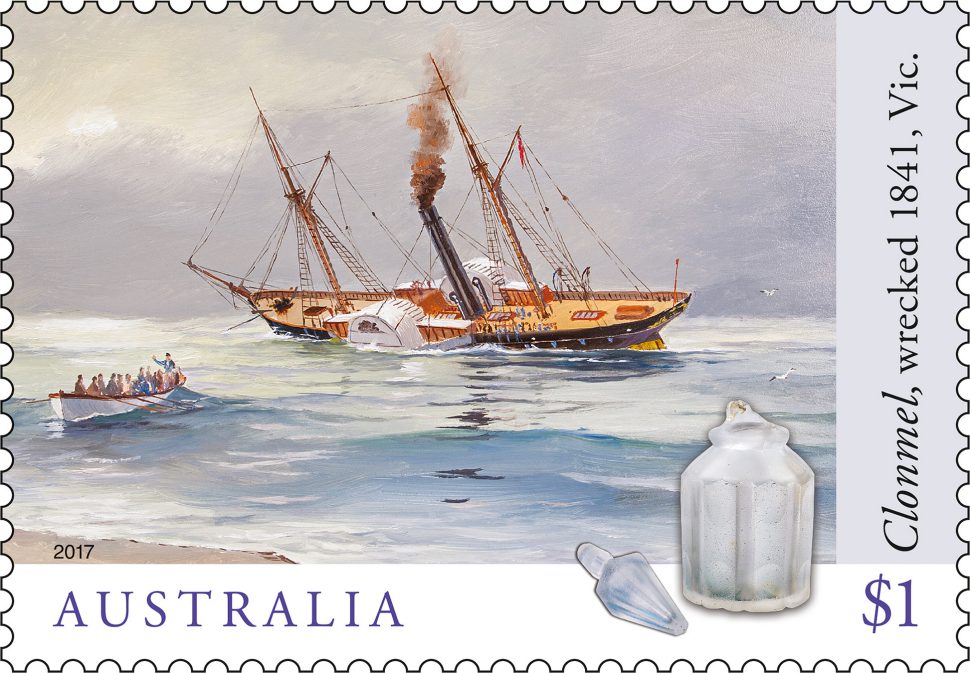In our first instalment of this three part Shipwrecks article series, we spoke to artist Adriaan de Jong about the meticulous process involved in researching and painting the Zuytdorp shipwreck.
In our second article, we spoke to curators from the Queensland Museum Network about the fascinating tale of the HMS Pandora and its quest to locate and capture the mutineers of the HMS Bounty.
In this final instalment, we move to the mid-19th century – an era when steamships were becoming a commercially viable alternative to sailing ships.
PS Clonmel
Built specifically for the Australian intercolonial passenger trade between Sydney, Melbourne and Launceston, the paddle steamer Clonmel was arguably the first luxury steamship to operate in Australian waters. With the latest maritime technology from England and elegantly appointed cabins, Clonmel had the ability to travel between Melbourne and Sydney in 24 hours, which was an exciting development at the time.
The Clonmel departed Sydney, on only her second voyage, on 30 December 1840. She was bound for Melbourne, with 80 passengers and crew, including prominent bankers and business people, as well as a valuable cargo of bank notes and expensive drapery. During the morning of 1 January 1841, the Clonmel struck a sandbar on the east coast of Victoria. Using Clonmel’s whaleboats and quarter-boats, all 80 passengers and crew were eventually transported safely to shore. Everyone survived, though the ship sank.
Peter Harvey is Senior Maritime Archaeologist with Heritage Victoria. Peter is responsible for coordinating the protection, management and documentation of the approximately 650 shipwrecks known to have occurred around the coast of Victoria, including the Clonmel. In fact, Clonmel was the one of the first wrecks Peter dived on and researched when he commenced work as a maritime archaeologist. Peter also completed the first archival research on the wreck and was the first to produce a detailed underwater plan of the site.
“When we first visited the wreck in the early 1980s it was thought that it had very little archaeological value, because it appeared to be almost completely destroyed. But after I completed the site plan I began to suspect that there was much more of the wreck buried deeply in the sand on the site. That suspicion was confirmed a couple of years later when a massive movement of about five metres of sand uncovered the remains of the ship's engines, hull structure and cargo. That event prompted me to write a short booklet about the wreck and its archaeology. I have continued to return to the wreck every year or so to monitor changes and to continue gathering archaeological information from it,” says Peter.
Peter, of course, knows the story of the Clonmel inside and out, and it provides a fascinating window into shipping construction and commercial practices of the time.
“The Clonmel was brought to Australia in a time of economic depression. Its owners shouldered a large financial risk in bringing such a large expensive ship for from the UK to Australia. Prior the arrival of the Clonmel, transport of passengers and goods between Melbourne, Sydney and Tasmania was solely in sailing vessels, and more often than not in the smaller coastal sailing ships that were relatively uncomfortable and unreliable because they depended on the vagaries of the weather,” says Peter.
And there are insights into social history, too, as Peter explains further:
“The story of the Clonmel is also a window into the lives and motivations early Australians, from the entrepreneurs led by Edye Manning who with his partners brought the ship to Australia, or the newly married Cashmores who lost the stock of a new shop they had hoped to establish in Melbourne, or the master Captain Tollervy whose actions resulted in the loss of the vessel, or the crew who bravely rowed one of the ship’s boats to Melbourne to raise the alarm.”
“Some recent research has uncovered a first-hand account of one of the passengers on board at the time of the wreck who hints at some malicious behaviour on the part of the crew that supposedly led to the wrecking of the ship. I think the story of the Clonmel, in one way or another, touches on just about every theme in the history of south-eastern Australia!” adds Peter.
The Clonmel is also incredibly important from an archaeological points of view. It is the oldest located steamship wreck in Australia and provides unique insight into the history of shipbuilding.
“The Clonmel represents a period of transition in shipbuilding. It was amongst the first vessels to be built at a time when steam engines had evolved to a point where they could compete commercially with sail-driven ships. It was also built at a time where wooden ships had evolved to their maximum viable size. The only way to viably increase the carrying capacity of ships was to move to iron construction,” notes Peter.
But Peter believes that the most interesting stories that come from the Clonmel are the human stories we can glean from the study of the artefacts found with the wreck: “These artefacts embody the hopes, dreams, ambitions and the everyday lives of those on board who handled and used them.”
While Peter finds it hard to single out a few artefacts as his favourites, preferring the picture created by the entire collection, he can name three as especially remarkable and memorable:
“This spoon is almost perfectly preserved. I discovered it on my first dive on the site. Neatly engraved on the handle in cursive scrip is just one word: "Clonmel". For me as a junior archaeologist, that find was a gift. I had positively identified the wreck on my first dive!” says Peter.
“This artefact gives a first-hand insight to what life on board the Clonmel must have been like. This object told me that, for the early colonists (at least those wealthy enough) the days of long voyages between colonies sometimes in small cargo ships with rough crews and uncomfortable accommodation, were over. From now on it was going to be an overnight trip between Melbourne and Sydney – sipping brandy from expensive crystal glassware before retiring to a luxurious private bed,” says Peter.
“We were lucky enough to see this when the site became fully uncovered in the early 1990s. This one relatively small object enabled me to visualise the entire ship in its heyday, with polished brass gleaming and stem billowing from the funnel as the paddle wheels whipped the sea into a foam,” says Peter.
Some of the Clonmel artefacts are housed at the Port Albert Maritime Museum (and others also made their way into the Anglican Church in Port Albert, including a stunning curved wooden rail and two ornate salon chairs.) While there are strong legislative protections in place, to prevent unauthorised diving on wreck sites or looting of artefacts, Peter believes that public education is vital.
“One of our main obligations as public archaeologists is to ensure that the results of our work are made available to the people who paid for it: the public. Heritage Victoria has worked in partnership with the Port Albert Maritime Museum in the past to ensure that at least some of the artefacts from the Clonmel are available for people to see and enjoy or to research,” says Peter.
Public education is also part of why Peter is very pleased that the Clonmel will appear on a stamp.
“I'm really delighted. I hope that it will encourage others to look in detail at some of the thousands of other shipwrecks around the Australian coastline,” says Peter.
To learn more about the PS Clonmel, visit the Heritage Victoria database and Flickr album, or read Peter Harvey’s publication on the topic.
To learn more about all three shipwrecks, read our fascinating and informative prestige book.
Other articles in this series:
Shipwrecks – capturing our maritime past: Part 1 (Zuytdorp)
Shipwrecks – capturing our maritime past: Part 2 (Pandora)
The Shipwrecks stamp issue is available from 29 August 2017, online, at participating Post Offices and via mail order on 1800 331 794, while stocks last.
This article was produced at the time of publication and will not be updated.




